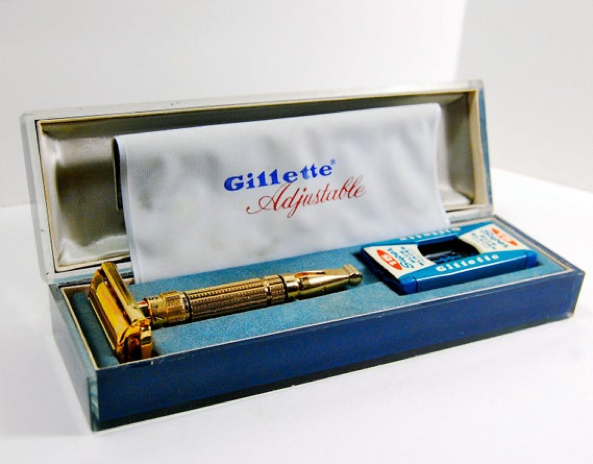The Gillette Toggle is considered by some the holy grail of vintage razors. Some may be asking what makes the Toggle (or the Super Adjustable as it was known) so desired? That is due to the unique way in which the doors open to insert a blade and the limited production run.

As noted in the photo advertisement above, the doors open by way of the bottle lever that toggles horizontal (doors closed) and vertical (doors open) which fully opens the doors of the razor. Previous razors were twist top open (TTO) that required a few twists of the dial to open the doors. The toggle mechanism led to quicker blade insertion as well as made it easier to clean following the shave.
Another aspect that made the Toggle unique was the adjustment dial. This was the first razor offered by Gillette that was adjustable, allowing the user to change the blade exposure to customize their shave. A lower setting on the dial would equal a milder shave. The higher numbers meant more blade exposure. This adjustment mechanism soon became a staple for Gillette later models of razors well into the 1980s, what we call today the Fatboy, the Slim, and the Black Beauties.
The Toggle was produced between 1955 and 1960 and surprisingly came in five varieties. The first version had an adjustment dial that went from 1 to 5, with adjustments every half number. This means the razor had a total of 9 adjustment options. This version came with a leather case, was gold plated, and only had serial numbers for identification. However, there is a report of a person who found a date code underneath the blade bed when he disassembled one for service.
The second version, and an extremely rare version is an A-3 nickel plated model that is the same design as the original gold-plated version.
The third version is a standard Super Adjustable that was widely distributed. This versions adjustment dial had nine adjustment numbers, instead of the five as in previous models. This version came in a blue case and have a date code of D-1
The fourth version has a date code of F-4. This version has a blade tray and adjustment indicator that is different from the other versions of the Toggle. It also has an external spring that is similar to those found on the bottom dial adjustable razors from Gillette.
The last version of the Toggle was identical to the D-1 version of the razor (with the nine numbers on the selection indicator), have a date code of F-1 and came in a blue case. This version is also the one that was produced the most.

After some tests in various markets, Gillette sent an internal memo stating that the Toggle was to be released for Christmas 1957, would be gold plated and come with a pack of 20 blades, all for $10. By April 1958, 70,000 Toggles were produced.
You may be asking yourself why the Toggle was only produced for such a short time. The answer is kind of simple, consumers seemed to prefer the twist to open design. Once Gillette moved the adjustment dial to the top of the handle, that resolved the majority of the issues they received during their initial tests of the Toggle and regular TTO adjustable razor. The Toggle was distributed into the fourth quarter of 1960 before being completely discontinued in favor of the much more popular Fat Boy.
Do you have a Toggle? Have you used one? Do you want one? Let us know in the comment secion.


2 comments
I will love to have one of thouse
I found a Janus toggle.
Well. It’s not a 70.000 pieces production. But a 51 pieces.
It’s a very nice razor and provides me the best bbs I can get. Some say it’s to aggressive made. I can use a green Astra blade in the first pass on 5. The second pass I do at 2.
Perfect.